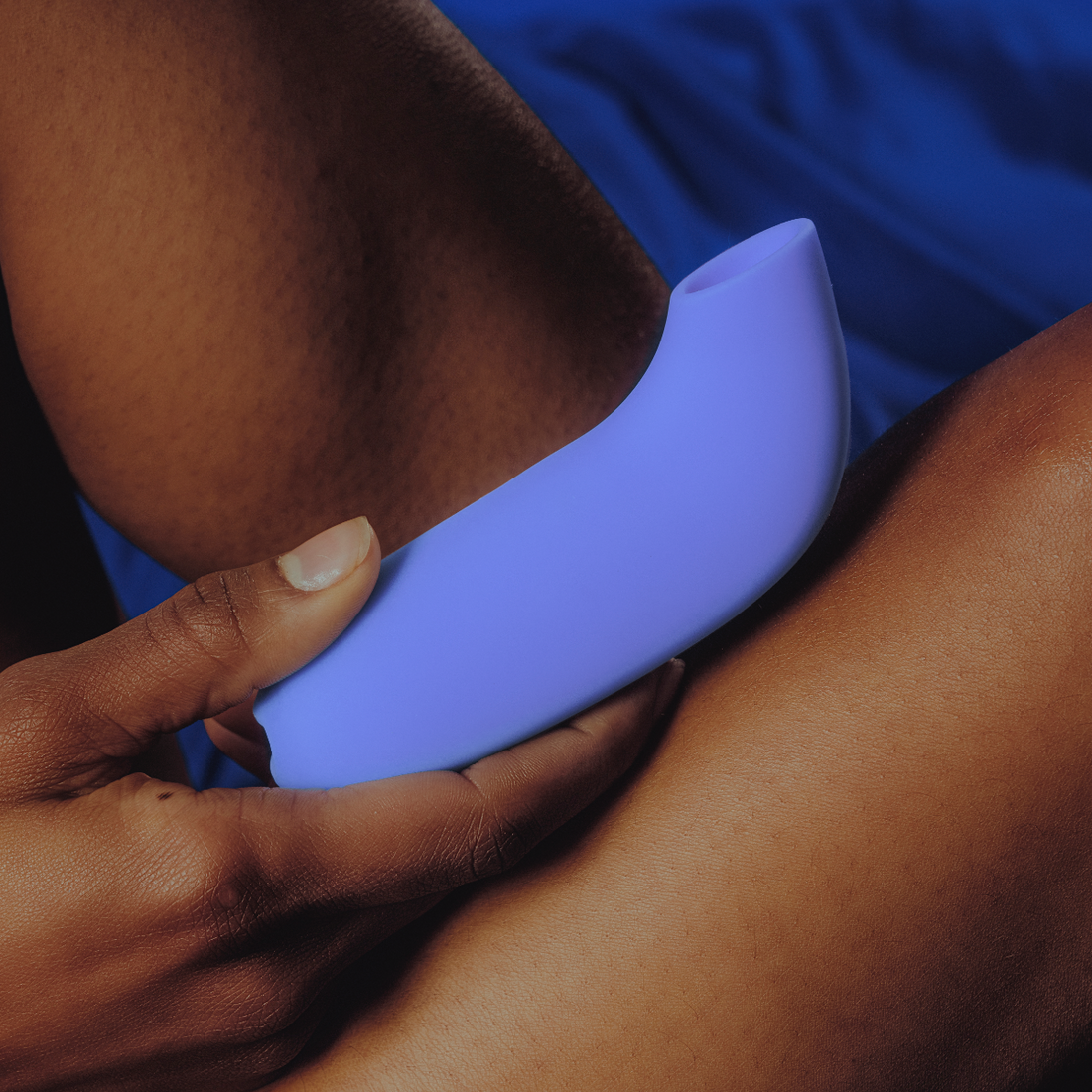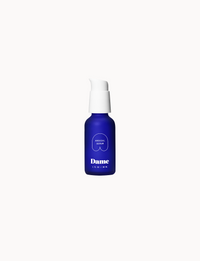Alexandra Fine, Credentialed Sexologist, M. Psych | Written by Dame
What is Edging? | Basics of an Orgasm | Mechanics of Edging | Potential Benefits of Edging | Potential Hazards of Edging
If you’re looking to maximize pleasure, you really need to learn about edging.
No, we’re not talking about the best way to use decorative edging in your garden.
Nor are we discussing the proper way to trim a beard, or a landing strip down below.
And we’re not referring to someone who’s nervous, or avant-garde. That’s “edgy,” not “edging.”
The edging we’re concerned with is something you may have done many times without realizing there’s a cool name for it.
There are lots of other names for it, too: peaking, surfing – and most accurately – orgasm control.
Those who are new to the concept may wonder why anyone would want to “control” their climax. After all, many have difficulty even reaching orgasm.
Actually, people who are unable to reach a satisfactory finish should probably wait until they’ve cleared that hurdle before they tackle edging. Once they’re able to regularly climax, though, they’re likely to find that edging can help them enjoy better orgasms, and last longer during masturbation and penetrative sex.
Here’s what you need to know.
Exactly What is Edging?
Edging, in its simplest terms, is stopping yourself from reaching climax just before you get there. (You’re right “on the edge” of orgasm. Get it?)
Then, after a brief pause, you go back at it. You repeat the process as many times as you’d like, extending the sexual experience until you decide to let go. Those who enjoy edging say it prolongs their excitement and makes orgasms more intense.
All of that is easier said than done, of course.
Edging requires you to be familiar enough with your body’s responses to sexual stimulation that you know exactly when to stop. You must also have enough self-control to be able do it.
That means there’s little chance of mastering the technique without patience and practice. Want to give edging a try? We’ll walk you through it. But in order to control your orgasms, you first need to understand the stages of arousal that lead to climax. Otherwise, it will be hard to tell when you’re “on the edge” but still have enough time to call a temporary halt to the proceedings.
The Basics of an Orgasm
In 1966, legendary sex researchers Masters and Johnson released their groundbreaking book, Human Sexual Response. In that work they described a four-phase sexual response cycle (SRC), which explained exactly what happens when people – whether they have vulvas or penises – become aroused and reach orgasm.
The SRC is still accepted as gospel by most therapists and sexologists, and it explains the physical sensations of sexual activity, arousal and climax. Understanding the four stages makes it easier to know when you’re approaching orgasm, and when to stop.
- Excitement: In the first phase, more commonly referred to as arousal, heart rate increases, muscles tense and more blood flows to the genitals. As a result, nipples get hard, the clitoris swells or the penis becomes erect, and lubrication begins. There’s no way – or reason – to stop the process here if the goal is edging.
- Plateau: The effects that begin during excitement become more pronounced. Muscles are even more tense, blood pressure and heart rate accelerate rapidly, the testicles tighten or the clitoris becomes extremely sensitive and retracts, and muscle spasms are likely to begin. It’s important to understand exactly how your body responds during this stage if you’re going to try edging, because the only time you can effectively prevent orgasm is in the final moments of plateau.
- Orgasm: Muscles spasm in the genitals and throughout the body, ejaculation occurs, and a sensation of relaxation replaces sexual tension. If you’ve reached this phase, it’s too late to edge.
- Resolution: This is when the body returns to “normal” and the release of the “cuddle hormone” oxytocin creates a warm sense of wellness and intimacy. Vulva-havers may be able to go right back into the earlier stages again, but most penis-havers require a “refractory period” during which their body recharges.
Edging requires practice, ideally via masturbation. That way, you’ll become intimately familiar with your body’s reactions as it progresses through the phases of the SRC, allowing you to stop things in time.
Exactly how do you stop it? Let’s look at that next.
The Mechanics of Edging
There are several methods you can use to enjoy the benefits of edging.
Stop-Start
The simplest and most common way to edge is by using what’s called the “stop-start” method, during the plateau phase of masturbation. This approach can be used by those of any gender, but it’s most effective – and easiest – for those with penises. The mechanics of stop-start aren’t difficult; it’s the timing that usually takes some practice.
Ready for the detailed instructions? Stop stimulation when you’re very close to an orgasm (some people prefer to just slow down), then wait at least a few seconds for your breathing and heart rate to ease a bit. When you feel that you’ve backed away from the edge of climax, resume the stimulation to bring yourself back to the brink again.
You can repeat as many times as you’d like but when you’ve decided that the buildup has gone on long enough, let yourself finish instead of stopping. Hopefully, you’ll experience a stronger and more intense orgasm than you’re accustomed to.
Stop-start may sound “too simple” to be rewarding. It is simple, in a way. The challenge is to become familiar enough with your own body and its responses, so you know exactly when to stop the stimulation and when to resume. That’s where the practice comes in.
One pro tip: when you pause your masturbation, don’t allow your attention to wander. That can cause you to lose your erection or lubrication. Breathing deeply while staying focused on the activity at hand (no pun intended) should let you get back into the swing of things as soon as you’ve successfully backed away from the edge. One variation on stop-start may help: briefly diverting your attention from the genitals by gentle stimulation of a different erogenous zone.
You can use the stop-start method during penetrative sex, oral sex or other types of partnered sex play as well, but stopping in the middle of the act – at exactly the right time – can be difficult. It’s best tried by two people who communicate well, and are experienced with each other’s bodies and sexual responses.
Squeezing
This one is only for penis owners, and it’s exactly what it sounds like. Just before you’re about to ejaculate, stop masturbating (or penetrating) and squeeze the frenulum – the area where the head of the penis meets the shaft – for 15 seconds or so. Then wait another 15 seconds before resuming stimulation. (Some find it easier or more effective to squeeze further down the base toward the shaft.) The squeeze method works because it closes off the urethra, preventing ejaculation.
Masters and Johnson first wrote about the squeeze technique in their book Human Sexual Inadequacy back in 1970. They promoted it as a way for penis-havers to control premature ejaculation, claiming that it helped 85 percent of their patients who tried it for three months.
Certified sex therapists (CSTs) and sexual wellness counselors still suggest squeezing as a treatment for ejaculation issues, but these days it’s more commonly used as a way to learn orgasm control. In fact, it’s often a stepping-stone to the stop-start method, because direct physical intervention is easier than pausing at the right moment.
The squeeze method can be used during mutual masturbation, as long as the partners have agreed on signals or verbal cues, but it’s really too cumbersome to be effective during penetrative sex.
Ballooning
Squeezing can be an introduction to edging, but ballooning takes it to the next level. Explaining this technique requires a little extra information, so stay with us for a minute.
Most people have heard of Kegel exercises because they’re often suggested during pregnancy. Kegels strengthen the pelvic floor muscles, which are important for proper bladder and bowel function, and are at major risk of damage during pregnancy and childbirth. Strengthening the pelvic floor can help in other ways, too; it may help prevent lower back pain and painful intercourse in vulva-havers, it may reverse or prevent erectile dysfunction in penis-havers, and it can improve sexual pleasure for all genders.
OK, back to ballooning, which is somewhat like the stop-start method. But when you briefly interrupt sexual stimulation you don’t “use your mind” to prevent orgasm, you “use your body” to do Kegel exercises instead. Naturally, this technique requires takes practice, and you first have to learn how to do Kegels.
You may be wondering at this point why this method is called “ballooning.” It’s simply a reference to an erection “inflating and deflating” during the edging process – even though those with vulvas can also use the balloon technique to delay orgasm.
Toys
Here’s a variation on stop-start that works best for vulva-havers: using a vibrator for clitoral stimulation, and turning it off for 10-15 seconds just before climaxing. It’s not a fail-safe method, of course, since it still requires practice and self-control. But vulva owners who’ve tried it say they’ve found edging with toys to be easier to master than the other alternatives.
Mindfulness and Tantric Sex
Several alternative approaches to sexuality incorporate edging in their practice.
Advocates of mindfulness – the practice of fully focusing on body, mind and feelings in the present moment – believe that staying in the moment also allows them to delay orgasm. They say that proper focus puts them in touch with the sensations they experience during the plateau phase of the SRC, and lets them know exactly when to slow down and when to resume stimulation.
Here’s a similar approach. If you’re not into tantric sex, you’re likely to think of it as a slow, deliberate and somewhat complex way to experience sexual pleasure. That’s true, but the breathing, positions and spiritual awareness inherent to tantra are all aimed at producing pleasure.
And edging is regularly used in tantric sex. It’s usually accomplished by pausing and inhaling deeply just before orgasm, while visualizing sexual energy traveling from the genitals to the mind. When done repeatedly, devotees say, this technique can produce mind-blowing, full-body climaxes when the time for release arrives.
Edging and BDSM
This is a little off the beaten track for most people, but orgasm control can play an exciting role in kinkier sex.
Delaying or denying orgasm is often used in BDSM play as a form of dominance (and by extension, submission). The dominant partner increases their feelings of power by controlling when or if the submissive partner can climax, and being required to edge adds to the submissive’s desire to feel controlled and subservient.
Potential Benefits of Edging
We’ve mentioned several of the reasons you might want to try edging or make it a regular part of your sex life. Let’s look more closely at the ones we’ve already discussed, and consider several other possible benefits.
Stronger Orgasms
There’s no way to scientifically measure the strength of an orgasm, but anecdotal reports vouch for edging’s ability to make climaxes more powerful. For example, a huge study of 20,000 participants, collated by a commercial site dedicated to vulva-havers’ pleasure, found that two-thirds of those who’ve tried edging say they experienced longer-lasting, more-intense orgasms.
Preventing Premature Ejaculation and Lasting Longer
As we’ve already discussed, edging is a proven technique to help penis owners overcome premature ejaculation. Anecdotal evidence also shows that those who don’t have that problem can still benefit from the practice, by learning how to last longer before reaching orgasm. In either case, edging can help a penis-haver prolong their staying power.
And that’s an important component of satisfying penetrative sex, since “timing” is obviously one of the biggest challenges in sexual encounters between those with vulvas and those with penises.
You probably don’t need statistics to prove that it takes one group much longer to climax than the other, but here they are anyway. Studies published in the Journal of Sexual Medicine report that the average time it takes for vulva-havers to reach orgasm is 13.41 minutes, while penis-havers achieve orgasm in an average of 5.4 minutes.
Edging can help noticeably close that gap, increasing sexual satisfaction for both sides.
Building Body Confidence and Self-Awareness
Almost every adult has sex, whether it’s with same- or opposite-gendered partners. In the most sexually-active demographic group, according to the National Survey of Family Growth, only seven percent of those between the ages of 25 to 44 said they hadn’t had any sexual partners within the past year.
Having sex, though, doesn’t necessarily mean you’re comfortable with your body and your sexuality. For instance, a survey of doctors and health professionals found that anywhere from 25% to 75% of their patients suffered from anorgasmia (inability to achieve orgasm), low sex drive, or another sexual dysfunction. But most of the patients were hesitant to bring the subject up in order to seek medical advice, largely because they were too embarrassed to do so.
The more comfortable you are with your body, the more able you are to discuss sex with both your doctor – and also your partner. You’ll also be more open to the exploration and experimentation that allows you to maximize sexual pleasure.
Edging can factor into both sides of that equation. It can boost your confidence, by helping you develop greater self-awareness about your body, sensations and feelings. And just as importantly, it can help maximize your pleasure in the bedroom while adding a new dimension to your sex play.
Potential Hazards of Edging
Let’s be clear: you can’t do serious or permanent damage to your genitals by edging. However, there are some issues that you might run into.
The most common complaint voiced by those who have started experimenting with edging is that they’re having “disappearing orgasms,” “half-orgasms” or “dry orgasms.” In other words, it feels that a climax is incomplete, or that it was almost there but then just vanished.
That feeling can be frustrating, but there’s no reason to worry. Disappearing orgasms are simply a sign that you haven’t gotten the timing right and need more practice. If you experience a disappearing orgasm try waiting a bit longer before stopping your climax, or resuming stimulation more quickly after pausing. The issue itself will disappear as soon as you get good at edging.
Another worry that some people have is that edging will train their body to always delay orgasms. They fear that regular edging will make it difficult or impossible to climax normally, leading to epididymal hypertension (better known as “blue balls”) in penis-havers. That’s just a myth; the body is very good at adjusting to the type of sexual stimulation or sex play it’s experiencing, and it can easily handle both edging and more “standard” sexual activity.
The only real hazard of edging is that it can become addictive, just like any type of sexual behavior. That’s not necessarily a problem for someone who limits the practice to solo masturbation sessions, but it can definitely interfere with partnered sex. More specifically, if one partner wants to experiment with edging but the other just wants to climax, that can lead to short- or longer-term relationship issues.
Any sexual encounter should be consensual, of course. But that doesn’t just mean consenting to sex – it also means agreeing on what types of sex the partners are going to have. Just as with any other form of sex play, there should be mutual consent before edging enters the picture, along with an agreement that either partner can end the experience at any time.
Is edging complicated? Somewhat. Is it worth it? Absolutely.




















































